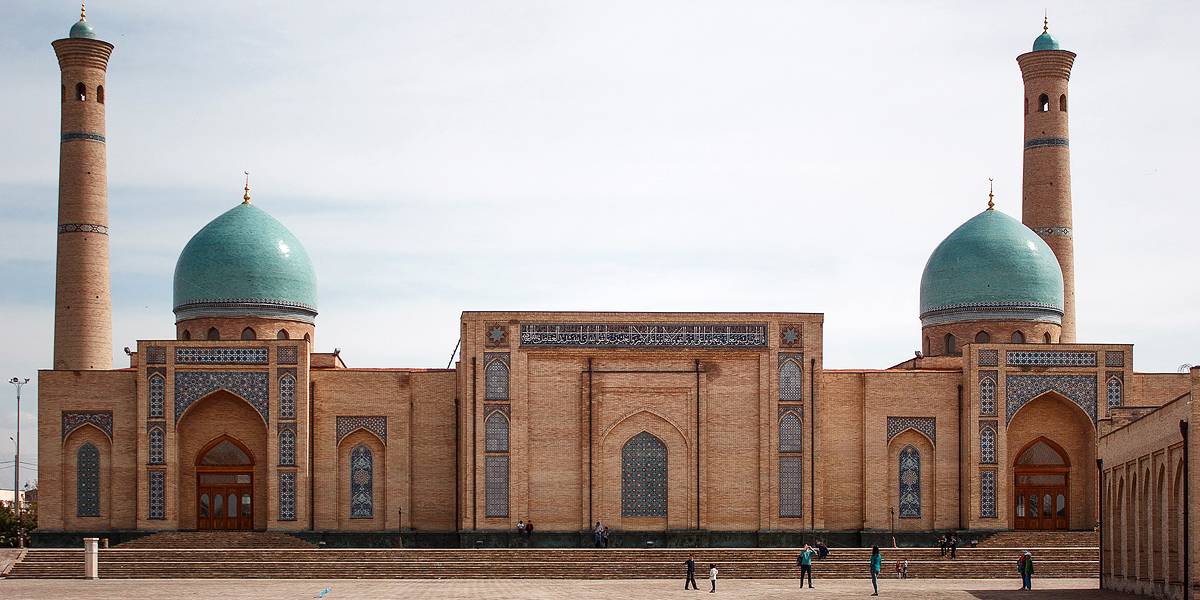Tashkent, Uzbekistan
Uzbekistan’s capital city Tashkent is a modern megapolis with several well-preserved ancient monuments. Plan your trip to Tashkent with our travel guide at holidayexplorer.in.


Tashkent is the capital of Uzbekistan and is a metropolis of over 2.5 million people. It is an ancient city and prospered due to its position on the Great Silk Road, which brought goods from China to Europe. Tashkent was extensively rebuilt following a major earthquake in 1917, and today, it is a modern, exciting city, with many faces.
Tashkent has its own unique flavour. It tastefully combines medieval buildings that look like they’re from the pages of ancient oriental tales, with elegant European architecture from the time of the Turkestan governorship, concrete ‘blocks’ from the Soviet era and, finally, sparkling high-rise commercial buildings made of glass and concrete that represent a new era of independent Uzbekistan.
Tashkent is one of the oldest cities on the Great Silk Road between China and Europe. The earliest references to Tashkent as a city settlement appeared in written sources in the 2nd century BC. In the Chinese annals the city is called Yueni or Shi; in the records of the Persian king, Shampur, it appears as Chach; and in other Arabic sources, Shash. The name Tashkent first appeared in Turkish documents of the 9th to 12th centuries.
From ancient times, a favourable geographical position and mild climate made Tashkent one of the main Silk Road cities. In the 14–15th centuries it was the part of the Timurid Empire, and in the 16th century it was under the control of the Sheibanids dynasty. In 1865, after the conquest of Mikhail Chernyaev, Russian military leader, the city became under the rule of the Russian Empire and Russian government was established here. In 1930 Tashkent was declared the capital of Uzbekistan, former Uzbek SSR.
Wide avenues, green alleys, fountains and eco-parks for leisurely walks;
Unique artifacts about the history and culture of the peoples of Central Asia in the numerous museums of the city;
Majestic architectural ensembles, mosques and minarets;
Theaters and galleries for every taste.
It’s the oldest subway system in Central Asia and each station has a different theme. In 1971 construction began, and the metro opened officially in 1977, doubling as a nuclear fallout shelter. The rules in the country are changing rapidly and just recently, they now allow photos in the stations.
Have a look at these stops: Kosmonavtlar, a station famous for portraits of cosmonauts, the Alisher Navoi station (photo above) contains mosque-like architecture, Bodomzor, and Mustakillik Maydoni, which has giant chandeliers hanging from its ceiling.
Madrasah Kukeldash is located on a high hill in the area of Chorsu square. The builder of the madrasah was a vezir of the Tashkent khans (1551-1575), called Kukeldash ("the foster-brother of the khan"). The madrasah has a traditional composition: an extensive court yard, built on khudjras, with darskhana and a mosque in the corners.
Chorsu Bazaar is Tashkent’s most famous farmers market, topped by a giant green dome, is a delightful slice of city life spilling into the streets off Old Town’s southern edge.
The market has been going for centuries, but it was the Soviets who constructed and covered it with the blue-domed building. All the locals come to the bazaar, which means that this is also a great place to observe the ethnic and cultural blend Tashkent is famous for.
From all kinds of fruit and meat to underwear and handicrafts, here you can find absolutely anything you want. I strongly recommend you buykurut, a Central Asian snack which consists of dried cheese balls.
Central to the modern city, Amir Timur Square is a lush, green space with plenty of flowers and fountains. Roads radiate from here to the north, east and south of Tashkent, and the city's most important buildings, both political and cultural, are concentrated on the square and in the immediate vicinity.
The tour through modern Tashkent would be better to start from Amir Temur square, that is literally forms the centre of Tashkent and from where you can move in any direction to explore that or another part of Tashkent. In the centre of the square you will find a statue of Tamerlane on horseback that is the latest political statement to mark Uzbekistan's rites of passage.
In the capital of Uzbekistan, on the bank of the Ankhor river, there is a Minor mosque - one of the newest attractions of Tashkent.
In the capital of Uzbekistan, on the bank of the Ankhor River, there is a Minor mosque - one of the newest attractions of Tashkent.
The opening of the mosque took place before a significant event for the Muslim world – the Eid al-Fitr holiday in 2014.
During construction, all the norms for traditional Oriental architecture were observed, but the mosque differs from the more ancient ones in its white marble decoration. It can accommodate more than 2,500 people. On Sunny days, the shrine shines in the sun.
The Minor consists of a grand avenue planted with greenery, and inside there is a large hall decorated with quotations from the Holy book of the Koran and a mark pointing to Mecca made of gold.
Despite the fact that this is a fairly young attraction, it must be visited.
The State Museum of History of Uzbekistan, previously known as the National Museum of Turkestan, was founded in 1876 and is one of the oldest museums of the Central Asia. The highlight of the museum is a very well preserved alabaster Buddha relief found from Fayaz Tepe in Termez. There are also a collection of Stone Age implements from the cave culture of Uzbekistan.
The tallest building in Central Asia and the 10th tallest in the world, the Tashkent TV Tower has a revolving restaurant at the top with fantastic views.
Tashkent’s numerous cafes and restaurants offer a wide range of cuisines including European, Russian, Asian (such as Korean, Chinese, and Indian), Middle Eastern, Caucasian, and, of course, Uzbek.
On almost every street there are teahouses and cafes (“Milliy Taomlar”, which means “national dishes” in Uzbek) serving traditional dishes like shashlik, shawarma, samsa, plov, naryn, manti, lagman, and shurpa. These venues offer high-quality, delicious, local foods at reasonable prices.
To combine shopping and entertainment, visit the Samarkand Darvaza, Mega Planet, Next, Parus, and Compass shopping and entertainment centres. These offer modern facilities including food courts, cinemas, children’s play areas, and many shops selling international brands.
The charm of shopping oriental style—with friendly sellers and stalls laden with fresh vegetables and fruits, fragrant spices, hot lepeshka (non) bread, and all kinds of goods—lives in Tashkent’s vibrant bazaars. Chorsu and Alay Bazaars are the most popular among tourists.
Tashkent has a continental climate, hot in summer and cold in winter. April, May, September, and October are the best times to visit.
Flying is the most convenient way to get to Tashkent from other countries. The city is served by several international airlines, such as Aeroflot, Air Astana, Asiana Airlines, China Southern Airlines, Korean Airlines, Nordwind Airlines, Somon Air, and Turkish Airlines. The national airline, Uzbekistan Airways, offers regular flights to many European, Asian, and North American cities including Bangkok, Beijing, Delhi, Frankfurt, Istanbul, Kuala Lumpur, London, New York, Paris, Seoul, and Tel Aviv. It also flies to many CIS countries, as well as within Uzbekistan.
Although most international visitors arrive by air, Tashkent can also be reached by train from Russia or Kazakhstan. Trains are mainly used for travel within Uzbekistan, with regular trains between Tashkent and Samarkand, Bukhara, Urgench, Nukus, and other cities.
The main currency used in Tashkent is the Uzbek som. The most popular foreign currency is the US dollar, and the second most popular is the euro. The Russian ruble is less widely-used and may suffer from a poor exchange rate.
Foreign exchange bureaus operate at hotels, as well as in all banks. Many ATMs accept Visa and Mastercard.

Book with Us and Get Best Deals in
*Terms and Conditions applied